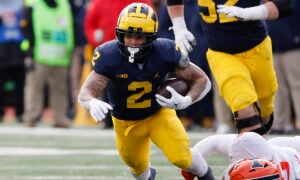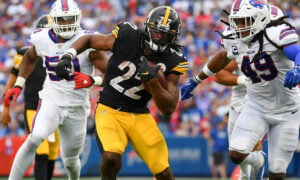Rookie Player Profile: David Cobb

Video Clip
[am4show have=’g1;’ guest_error=’sub_message’ user_error=’sub_message’ ]
Strengths
Standing 5’11” and weighing in at 229 lbs, Cobb is a powerfully built running back. He displays good initial burst at the snap of the football and he attacks the offensive line with conviction (a testament to his vision). Although Cobb is a one-cut runner at this stage in his development, he is more than capable of consistently beating the first defender. Against second level defenders, Cobb wins primarily with leverage and power. He rarely shies away from contact – in fact, Cobb’s ability to excel in physical situations is what makes him such a promising prospect. His experience running effectively in Minnesota’s hybrid running scheme (mixture of zone and gap) gives him tremendous versatility. Ultimately, I believe Cobb’s traits are best suited for a gap scheme at the next level .
Weaknesses
Cobb is not a burner by any stretch of the imagination. While he has sufficient speed to turn the corner on running plays to the outside, he is not adept at running in space. Cobb’s lack of lateral agility makes it difficult for him to make defenders miss consistently in the open field. In addition, Cobb needs to refine (like most collegiate running backs), his pass blocking technique. He is a willing blocker, but he needs to develop his punch and anchor better against pass rushers. Finally, Cobb’s proficiency as a pass catcher is somewhat of an unknown (34 career receptions at Minnesota). In order to become a three down back in today’s NFL, Cobb needs show he can be a competent receiver out of the backfield.
Opportunities
The Titans essentially re-made their offense in the 2015 NFL Draft. Although Cobb was drafted in the fifth round, his price tag shouldn’t fool you into thinking he is going to warm the bench this season. Cobb will likely be in competition with Bishop Sankey for the starting job once training camp officially opens. While Cobb will likely be in a committee with Sankey to start the season, I believe he will ultimately overtake the incumbent early. Cobb’s physical running style translates well to the NFL, and for a team with a rookie quarterback, the running game will be a crucial component to the offense.
Threats
There are many who will argue Bishop Sankey’s struggles last season were a result of poor offensive line play. The numbers seem to support such assertions as the Titans were 26th in both total rushing yards (1,447) and rushing yards per game (90.4) in the NFL. The Titans also only managed a mere six touchdowns on the ground all year – good for 29th in the NFL. Now with a new offensive unit that includes Marcus Mariota, Dorial Green-Beckham and Tre McBride, not to mention late season improvement by the Titans offensive line, there many saying Sankey is poised to break-out.
The Titans were involved in several lopsided games last season in which the running game was quickly abandoned. In addition one of Sankey’s best assets as a running back is his receiving ability – late in games and being down by two or more scores renders most routes out of the backfield ineffective. The potential for a more balanced attack could afford Sankey a greater opportunity to make an impact. As we have already stated, Cobb is still a relative unknown as a pass catcher. If Sankey performs well as a pass catcher from the onset, it could limit Cobb’s role in the offense.
Expectations
Conservatively, Cobb offers owners RB3 to RB4 type numbers. He will most likely be deployed in short yardage and goaline situations immediately. For that reason, he offers reasonable scoring potential in both standard and PPR formats. If Sankey were to be injured, he could post RB2 numbers consistently throughtout the year.
In the long term, I expect David Cobb to eventually supplant Sankey as the starting running back in Tennessee. He has the potential to develop both physically (improved lateral agility) and technically (specifically as a pass catcher). While Cobb has the potential to flirt with RB1 numbers, I ultimately believe he will settle in as a strong RB2 for several years.
NFL Comparison:
Fred Jackson
Projected Range for Draft
Following the 2015 NFL Draft, Cobb’s ADP has him being taken as the 21st rookie off the board. Depending on roster size and scoring format, he could go as early as the top of the second round or as late as the end of the second. Cobb’s landing spot presents one of the most unencumbered paths to relevancy in this rookie class. As a result, you may need to earmark your second round pick in order to acquire him this year.
[/am4show]
- Tales from the Tape: How I Watch Film - July 7, 2015
- Rookie Player Profile: Duke Johnson - June 13, 2015
- Rookie Player Profile: David Cobb - June 7, 2015


































































